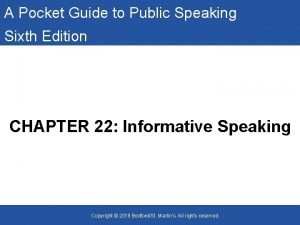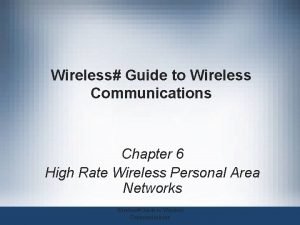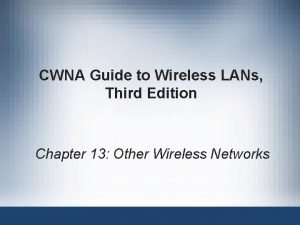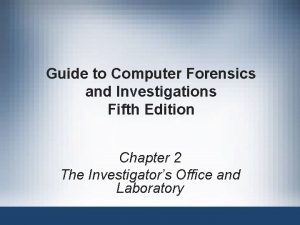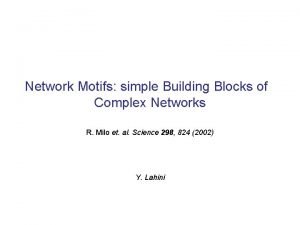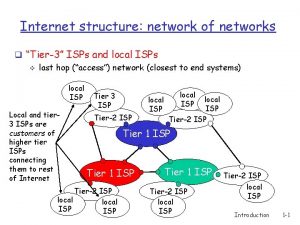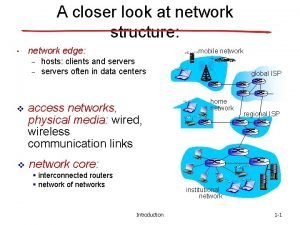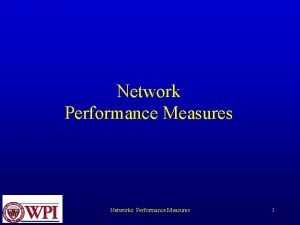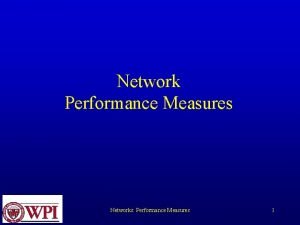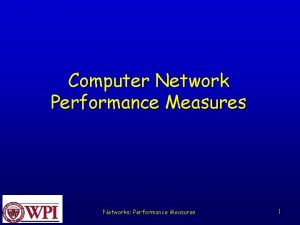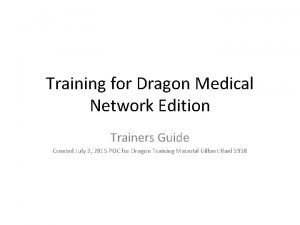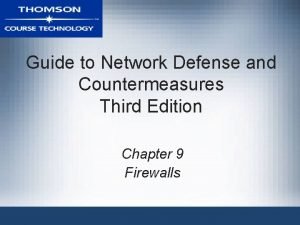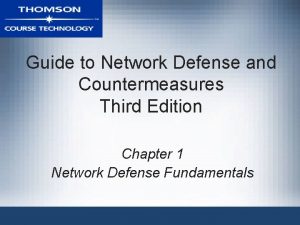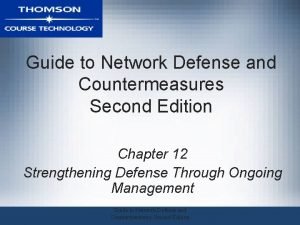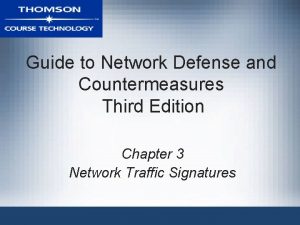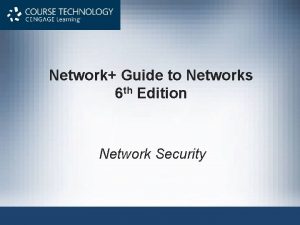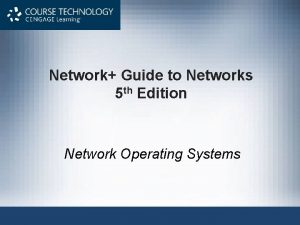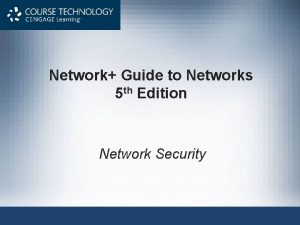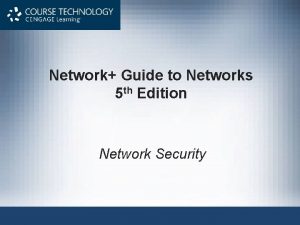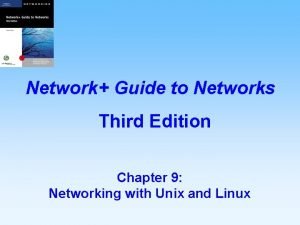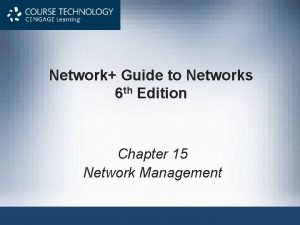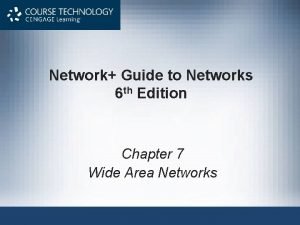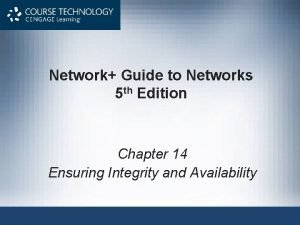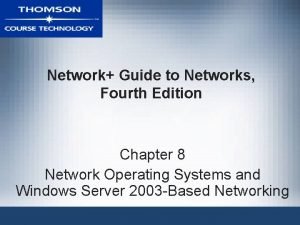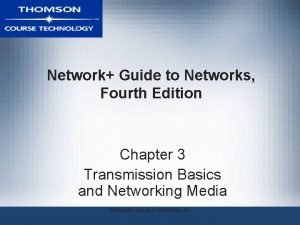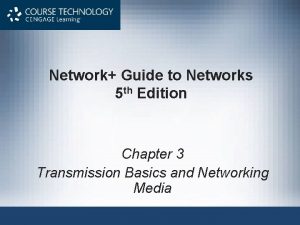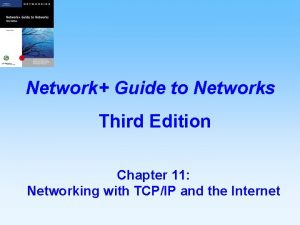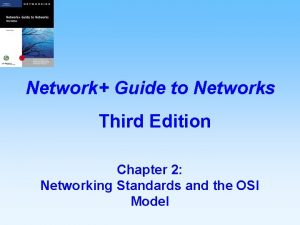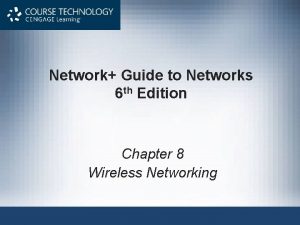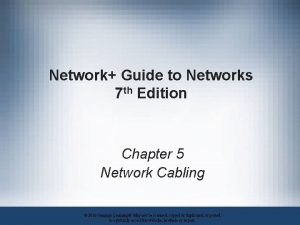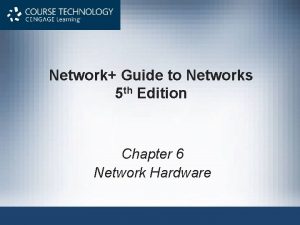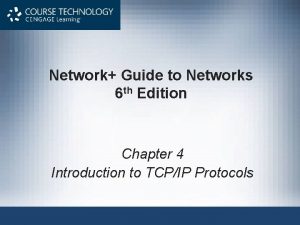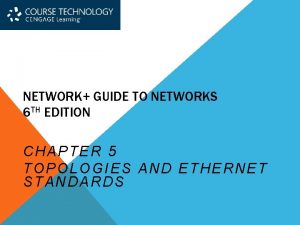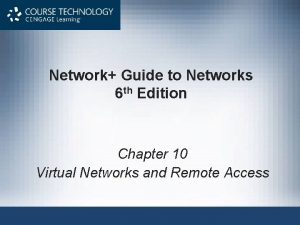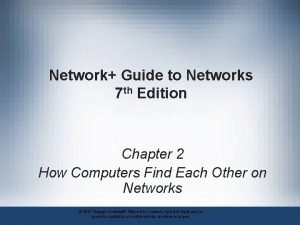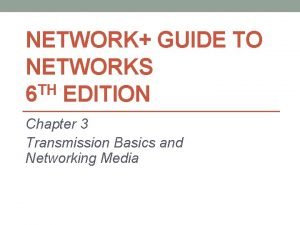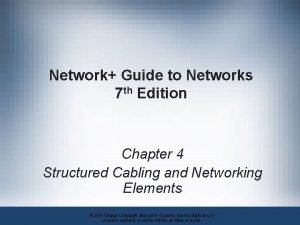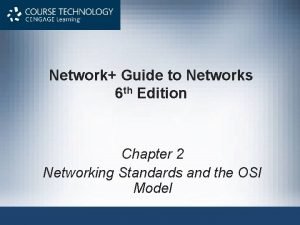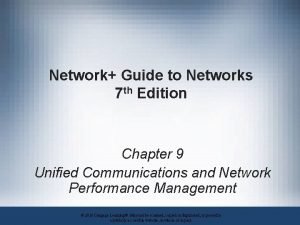Network Guide to Networks 7 th Edition Chapter














































- Slides: 46

Network+ Guide to Networks 7 th Edition Chapter 12 Industrial and Enterprise Networking © 2016 Cengage Learning®. May not be scanned, copied or duplicated, or posted to a publicly accessible website, in whole or in part.

Objectives • Identify significant components of an industrial control system or SCADA system • Inventory and manage network assets and identify significant business documents • Create and follow appropriate change management procedures for major and minor network changes • Identify significant physical security controls to limit or monitor access to secure areas • Describe the components of a reliable disaster recovery plan and a defensible incident response plan Network+ Guide to Networks, 7 th Edition © Cengage Learning 2016 2

Industrial Networks • Industrial system – A system of machines, such as an assembly line – Computers interact with machinery and physical components that are not digital or technical in nature – Could be spread over a wide geographical area • Such as a public transportation system or a gas pipeline • Internet of Things (IOT) – Consider by some to be the next generation of the Internet – Connects objects that are not used as computers Network+ Guide to Networks, 7 th Edition © Cengage Learning 2016 3

Components of an Industrial Control System and SCADA Network • Industrial control system (ICS) – Group of network computers used to manage a physical system of industrial processes • Basic components specific to an ICS: – – – Supervisory control and data acquisition (SCADA) Remote terminal units (RTU) Programmable logic controller (PLC) Communications channels Human-machine interfaces (HMIs) Network+ Guide to Networks, 7 th Edition © Cengage Learning 2016 4

Components of an Industrial Control System and SCADA Network • Basic components specific to an ICS (cont’d): – Software and ICS servers • Acquisitions server (I/O server) • Control server, MTU (master terminal unit), or SCADA server • Historian Network+ Guide to Networks, 7 th Edition © Cengage Learning 2016 5

Components of an Industrial Control System and SCADA Network+ Guide to Networks, 7 th Edition © Cengage Learning 2016 6

Components of an Industrial Control System and SCADA Network+ Guide to Networks, 7 th Edition © Cengage Learning 2016 7

Components of an Industrial Control System and SCADA Network • Two methods that an ICS might use to control the physical system: – Open loop system • Makes decisions based on predetermined expectations, events, and past history – Closed loop system • Makes decisions based on real-time data • Requires field devices distributed throughout they physical system to monitor aspects of the system (called a distributed control system or DCS) Network+ Guide to Networks, 7 th Edition © Cengage Learning 2016 8

Securing an ICS/SCADA Network • Recommended best practices: – Inventory all connections to your ICS/SCADA network – Segment your ICS/SCADA network from the corporate network – Isolate your ICS/SCADA network by deploying a DMZ between the corporate network and the ICS network – Completely disconnect the ICS/SCADA network from the Internet – Secure or harden the ICS/SCADA network by implementing strict firewall rules, IDS, and physical security controls Network+ Guide to Networks, 7 th Edition © Cengage Learning 2016 9

Securing an ICS/SCADA Network • Recommended best practices (cont’d): – For fault tolerance, deploy redundancy as appropriate – Harden the ICS/SCADA network by strictly controlling access to the network with encrypted authentication – Protect the historian – Make sure vendors responsible for supporting hardware and software on your network fully disclose any backdoor entrance into your network – If the ICS network provides W-Fi, consider installing Faraday cages around the Wi-Fi hot spots Network+ Guide to Networks, 7 th Edition © Cengage Learning 2016 10

Securing an ICS/SCADA Network • Recommended best practices (cont’d): – Keep current all documentation needed for configuration management – Keep well-documented and well-maintained backups of the system and its data – Clearly define risk management practices and establish risk management teams – Implement role-based access control (RBAC) to the system Network+ Guide to Networks, 7 th Edition © Cengage Learning 2016 11

Asset Management and Business Documents • Asset management documentation – Important when managing large numbers of devices – Essential in an enterprise environment Network+ Guide to Networks, 7 th Edition © Cengage Learning 2016 12

Asset Management • Refers to monitoring and maintaining all assets that make up a network • First step is to inventory all network components: – Nodes or hardware devices – Software • Organization needs determine appropriate asset management tool • Benefits – Simplifies maintaining and upgrading network – Provides information about hardware and software costs and benefits Network+ Guide to Networks, 7 th Edition © Cengage Learning 2016 13

Business Documents • Standard business documents you may encounter: – RFP (request for proposal) • Request to vendors to submit a proposal for a product or service your company wants to purchase – MOU (memorandum of understanding) • Documents the intentions of two or more parties to enter into a binding agreement, or contract – SOW (statement of work) • Documents in detail the work that must be completed for a particular project Network+ Guide to Networks, 7 th Edition © Cengage Learning 2016 14

Business Documents • Standard business documents you may encounter (cont’d): – SLA (service-level agreement) • A legally binding contract or part of a contract that defines the aspects of a service provided to a customer • Example: the service provided by an ISP – MLA (master license agreement) • Grants a license from a creator, developer, or producer to a third party for the purposes of marketing or sublicensing, or distributing the product to consumers Network+ Guide to Networks, 7 th Edition © Cengage Learning 2016 15

Change Management • Managing change while maintaining network’s efficiency and availability: – Requires good planning • Common software and hardware changes – Range from installing patches to replacing network backbone • Several ways to approach changes Network+ Guide to Networks, 7 th Edition © Cengage Learning 2016 16

Software and Hardware Changes • Three types of changes to existing software: – Patch • A correction, improvement, or enhancement – Upgrade • A major change to a software package that enhances the functionality and features of the software – Rollback • Also called backleveling or downgrading • Process of reverting to a previous version after attempting to patch or upgrade it Network+ Guide to Networks, 7 th Edition © Cengage Learning 2016 17

Software and Hardware Changes • General steps to change software or hardware – – Don’t allow patches to be automatically installed Determine whether patch or upgrade is necessary Research change purpose, compatibility, and effects Test the patch or upgrade in a testing lab to make sure it acts as expected – Determine whether changes should apply to all users, network segments, or devices – Schedule change for completion during off-hours • Called the maintenance window Network+ Guide to Networks, 7 th Edition © Cengage Learning 2016 18

Software and Hardware Changes • General steps to change software or hardware (cont’d) – – – Notify appropriate personnel of intent to change Back up current system Prevent users from accessing system during change Keep instructions handy as you install revision Implement the change and test system fully Re-enable access to the system • Or revert to previous version – Inform personnel that change is complete – Record change in the change management system Network+ Guide to Networks, 7 th Edition © Cengage Learning 2016 19

Software and Hardware Changes • Reversing a software upgrade – Software change may create unexpected problems – Be prepared to reverse an upgrade • Backleveling – Reverting to previous version of software after attempting upgrade – No hard-and-fast rules for backleveling – Always refer to software vendor’s documentation to reverse an upgrade • For NOS: consult other professionals as well Network+ Guide to Networks, 7 th Edition © Cengage Learning 2016 20

Software and Hardware Changes Network+ Guide to Networks, 7 th Edition © Cengage Learning 2016 21

Change Management Documentation • Generally, the larger an organization, the more documentation required when making changes • Required process will vary but expect the following: – – – Submit a change request document Understand follow the approval process The change is project managed (change coordinator) Provide additional documentation Close the change Network+ Guide to Networks, 7 th Edition © Cengage Learning 2016 22

Physical Security Controls • Restrict physical access to critical components – Only trusted networking staff should have access – A security policy should define who has access • Sophisticated door access controls: – Keypad or cipher locks • Cipher locks are physical or electronic locks requiring a code to open the door – Access badges • Proximity cards, passive cards, and active cards Network+ Guide to Networks, 7 th Edition © Cengage Learning 2016 23

Physical Security Controls Network+ Guide to Networks, 7 th Edition © Cengage Learning 2016 24

Physical Security Controls Network+ Guide to Networks, 7 th Edition © Cengage Learning 2016 25

Physical Security Controls Network+ Guide to Networks, 7 th Edition © Cengage Learning 2016 26

Physical Security Controls • Sophisticated door access controls (cont’d): – Biometrics • Scans an individual’s unique physical characteristics – Mantraps • Consists of two doors on either end of a small entryway • First door must close before the second door can open • AIT (advanced imaging technology) machines – Use millimeter-wave scanners to indicate on cartoonlike images any areas of concern to security personnel Network+ Guide to Networks, 7 th Edition © Cengage Learning 2016 27

Physical Security Controls Network+ Guide to Networks, 7 th Edition © Cengage Learning 2016 28

Physical Security Controls Network+ Guide to Networks, 7 th Edition © Cengage Learning 2016 29

Physical Security Controls • Many IT departments use video surveillance systems (closed-circuit TV) to monitor activity in secured rooms • IP cameras can be placed in data centers • A central security office might display several camera views at once – Or it might switch from camera to camera Network+ Guide to Networks, 7 th Edition © Cengage Learning 2016 30

Physical Security Controls • Important questions to ask when planning for physical security: – Which rooms contain critical systems or data and must be secured? – Through what means might intruders gain access to the facility, computer room, data room, network closet, or data storage areas? – How and to what extent are authorized personnel granted entry? – Are employees instructed to ensure security after entering or leaving secured areas? Network+ Guide to Networks, 7 th Edition © Cengage Learning 2016 31

Physical Security Controls • Important questions to ask when planning for physical security (cont’d): – Are authentication methods difficult to forge or circumvent? – Do supervisors or security personnel make periodic physical security checks? – Are all combinations, codes, or other access means to computer facilities protected at all times, and are those combinations changed frequently? – Do you have a plan for documenting and responding to physical security breaches? Network+ Guide to Networks, 7 th Edition © Cengage Learning 2016 32

Physical Security Controls • To guard against information being stolen from a decommissioned hard drive – Run a specialized drive sanitizer program to make file recovery impossible • Degausser – A magnetic hard drive eraser Network+ Guide to Networks, 7 th Edition © Cengage Learning 2016 33

Troubleshooting and Response Policies • Disasters and security breaches to happen • Training and preparation can make all the difference in your company’s ability to respond adapt to these situations Network+ Guide to Networks, 7 th Edition © Cengage Learning 2016 34

Disaster Recovery • Disaster recovery – Restoring critical functionality, data • After enterprise-wide outage • Affecting more than single system, limited group • Consider possible extremes – – Enterprise-wide outage Failures Security breaches Data corruption Network+ Guide to Networks, 7 th Edition © Cengage Learning 2016 35

Disaster Recovery Planning • Account for worst-case scenarios • Identify disaster recovery team (red team) • Provide contingency plans for restoring and replacing: – – Computer systems Power Telephony systems Paper-based files • Goal is to ensure business continuity – Ability to continue to do business Network+ Guide to Networks, 7 th Edition © Cengage Learning 2016 36

Disaster Recovery Planning • Sections of the plan related to computer systems should include the following: – Contact information for emergency coordinators – Details on which data and servers are being backed up, how frequently backups occur, where backups are kept, and how backed-up data can be recovered – Details on network topology, redundancy, and agreements with national service carriers – Regular strategies for testing the disaster recovery plan Network+ Guide to Networks, 7 th Edition © Cengage Learning 2016 37

Disaster Recovery Planning • Sections of the plan related to computer systems should include the following (cont’d): – A plan for managing the crisis, including regular communications with employees and customers • Having a comprehensive disaster recovery plan – Lessens the risk of losing critical data – Makes potential customers and insurance providers look more favorably on your organization Network+ Guide to Networks, 7 th Edition © Cengage Learning 2016 38

Disaster Recovery Contingencies • Cold site – Components necessary to rebuild network exist – Not appropriately configured, updated, or connected • Warm site – Components necessary to rebuild network exist – Some appropriately configured, updated, and connected • Hot site – Components exist and match network’s current state – All appropriately configured, updated, and connected Network+ Guide to Networks, 7 th Edition © Cengage Learning 2016 39

Forensics • Every security policy should include a response policy – Defines the characteristics of an event that qualifies as a formal incident and steps that should be followed • Qualifying incidents might include a: – – – Break-in Fire Weather-related emergency Hacking attack or malware outbreak Discovery of illegal content or activity Network+ Guide to Networks, 7 th Edition © Cengage Learning 2016 40

Forensics • Data collected might be presented in a court of law – Data must be carefully collected so that it will stand up to the scrutiny of the court • First responders may take charge – People with training and/or certifications that prepare them to handle evidence • Every IT technician should know how to safeguard sensitive information, logged data, and other legal evidence until first responder can take over Network+ Guide to Networks, 7 th Edition © Cengage Learning 2016 41

Forensics • A response policy should detail the following steps: – – – – Determine if escalation is necessary Secure the area Document the scene Monitor evidence and data collection Protect the chain of custody Monitor transport of data and equipment Create a report Network+ Guide to Networks, 7 th Edition © Cengage Learning 2016 42

Forensics • A response policy should identify members of a response team: – Dispatcher • The person to call who first notices the problem – Manager • Coordinates the resources necessary to solve the problem – Technical support specialist • Focuses on solving the problem quickly – Public relations specialist • Acts as official spokesperson for the organization Network+ Guide to Networks, 7 th Edition © Cengage Learning 2016 43

Summary • An industrial system is a system of machines, such as an assembly line at a tire manufacturing plant • An industrial control system (ICS) is a group of networked computers used to manage a physical system of industrial processes • Isolate an ICS/SCADA network by deploying a DMZ between the corporate network and the ICS network • First step in managing assets is to inventory all the components on the network • Be familiar with the following business documents: RFP, MOU, SOW, SLA, and MLA Network+ Guide to Networks, 7 th Edition © Cengage Learning 2016 44

Summary • Managing change while maintaining your network’s efficiency and availability requires good planning • Three types of changes to existing software include patches, upgrades or updates, and rollbacks • The complexity of a change approval process is usually determined by the cost and time involved in making the change, the number of users affected, potential risk to work productivity, and difficulty of rolling back the change Network+ Guide to Networks, 7 th Edition © Cengage Learning 2016 45

Summary • A security policy defines who has access to the computer room • A disaster recovery plan should identify a disaster recovery team, sometimes called the red team, with an appointed coordinator • Every contingency plan necessitates a site other than the building where the network’s main components normally reside • Some forensic data available for analysis can be damaged or destroyed if improperly handled Network+ Guide to Networks, 7 th Edition © Cengage Learning 2016 46
 Datagram approach
Datagram approach Basestore iptv
Basestore iptv Neural networks and learning machines 3rd edition
Neural networks and learning machines 3rd edition Using mis 10th edition
Using mis 10th edition Chapter 1
Chapter 1 Florida real estate broker's guide
Florida real estate broker's guide Florida real estate broker's guide
Florida real estate broker's guide A pocket guide to public speaking 6th edition free
A pocket guide to public speaking 6th edition free Guide to wireless communications 4th edition
Guide to wireless communications 4th edition Guide to computer forensics and investigations 6th edition
Guide to computer forensics and investigations 6th edition Prehospital emergency care 11th edition
Prehospital emergency care 11th edition Florida real estate broker's guide 6th edition
Florida real estate broker's guide 6th edition Florida real estate broker's guide 6th edition
Florida real estate broker's guide 6th edition Cwna guide to wireless lans 3rd edition
Cwna guide to wireless lans 3rd edition Building a forensic workstation
Building a forensic workstation Florida real estate broker's guide
Florida real estate broker's guide A pocket guide to public speaking 6th edition
A pocket guide to public speaking 6th edition A pocket guide to public speaking 6th edition
A pocket guide to public speaking 6th edition Dk guide to public speaking 2nd edition
Dk guide to public speaking 2nd edition Florida real estate broker's guide 6th edition
Florida real estate broker's guide 6th edition Florida real estate broker's guide
Florida real estate broker's guide Florida real estate broker's guide
Florida real estate broker's guide Pcnse certificate
Pcnse certificate Principles of network applications in computer networks
Principles of network applications in computer networks Network motifs: simple building blocks of complex networks
Network motifs: simple building blocks of complex networks The network layer is concerned with of data
The network layer is concerned with of data Tier 3 isps
Tier 3 isps Internet structure network of networks
Internet structure network of networks Network layer design issues in computer networks
Network layer design issues in computer networks Network performance measurement in computer networks
Network performance measurement in computer networks Network performance measures
Network performance measures Router node
Router node William stallings network security essentials 5th edition
William stallings network security essentials 5th edition Modulo table
Modulo table Dragon medical network
Dragon medical network Cryptography and network security 6th edition pdf
Cryptography and network security 6th edition pdf Cryptography and network security 4th edition
Cryptography and network security 4th edition Network security essentials 5th edition
Network security essentials 5th edition Cryptography and network security 7th edition
Cryptography and network security 7th edition Guide to network security
Guide to network security Guide to network defense and countermeasures
Guide to network defense and countermeasures Guide to network defense and countermeasures
Guide to network defense and countermeasures Information rules a strategic guide to the network economy
Information rules a strategic guide to the network economy Operational auditing
Operational auditing Guide to network defense and countermeasures
Guide to network defense and countermeasures Security guide to network security fundamentals
Security guide to network security fundamentals Security guide to network security fundamentals
Security guide to network security fundamentals







